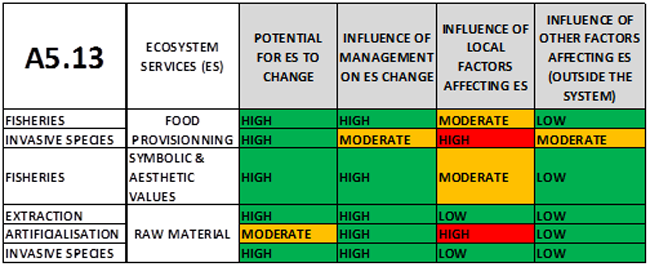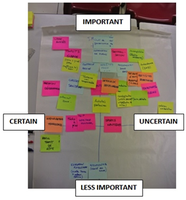5.4.8 Golfe Normand-Breton: Detailed description of the scenarios approach

The tools used to build the scenarios were chosen using the VALMER scenario technical guidelines ![]() . It was important to have a method allowing involvement of stakeholders in the determination of important elements to be considered and to construct the scenarios stories. The PESTLE analysis and matrixes
. It was important to have a method allowing involvement of stakeholders in the determination of important elements to be considered and to construct the scenarios stories. The PESTLE analysis and matrixes ![]() have been chosen as good way to do it.
have been chosen as good way to do it.
A Seminar on ecosystem services, four workshops and thirteen focus groups (bilateral interviews) were organized in order to identify the topics to be explored, to build the scenarios and to present them to stakeholders.
 Figure: Steps of the scenarios approach developed in the Golfe Normand-Bretoncase study site
Figure: Steps of the scenarios approach developed in the Golfe Normand-Bretoncase study site
Step1
In May-July 2013, the Golfe Normand-Breton team contacted local stakeholders to involve them in the VALMER project.
Step 2
On November,15th 2013: a “Common culture Seminar on the ecosystem services offered by the marine habitats of the Golfe Normand-Breton" and a " Workshop 1 on issues related to these ecosystem services” (Asking: “What are the services offered by the marine habitats in the Golfe Normand-Breton?” and “ What are the issues related to these services?”) were organised.
These proved useful in identifying general issues concerning the ecosystem services of marine habitats in the Golfe Normand-Breton:
- Soft sediments coastal habitats
- Energy offshore locations
- The marine harvesting activities (e.g. fishing)
Those issues were too general and concerning too many habitats, functionalities and services to be explored in scenarios. In order to define well-focused and realistic subjects for scenario development, the TRIAGE methodology ![]() has been done in strong collaboration with scientists of the VALMER Golfe Normand-Breton team.
has been done in strong collaboration with scientists of the VALMER Golfe Normand-Breton team.
Each general subject has been broken down into combinations of human activity-habitat-ecosystem services.
The 150 combinations obtained were tested by asking 3 questions:
- the ecosystem services potential of change
- the influence of the local management
- the effect of local vs. global pressures.

Table: Example of the TRIAGE process for the habitat Infralittoral coarse sediment (Eunis A5.13)
This process allowed us to defined 4 well-focused subjects:
- The future of the scallop’s resource harvested on soft sediment considering the implementation of management measures (e.g. fight against the invasive slipper limpet, fisheries management, development of new activities as offshore wind, shellfish farming).
- The future of bivalve exploitation relative to changes in practices (e.g. shellfish farming, leisure fishing) in a context of coastal population and activities increasing, and potential decrease of water quality.
- The future of foreshore’s recreational activities (access and share of the space) in a context of coastal population and activities increasing, and potential decrease of water quality.
- The future of exploited resources on offshore sands: fish, scallops in a context of practice’s changes (e.g. new offshore wind projects, fisheries protected areas).
Summary sheets of each topic were distributed to stakeholders in order to debate and try to find a consensus. Moreover, an anonymous web survey was undertaken to identify a consensus on the subject to be selected. The survey’s results were then completed by the existing scientific knowledge (qualitative and quantitative) for each subject, so as to determine a common topic, interesting and feasible to support a solid scenario development process.
Unfortunately, it was not possible to identify a single priority issue. It was therefore decided to work on two topics:
- Food services offered by coastal and offshore marine habitats
- Recreational services offered by foreshore marine habitats
Step 3
The aim of this workshop was to collect keys elements to construct the narrative scenarios. For this, the stakeholders were divided into four groups: two groups working on “recreational services” and two groups working on “food services”.
On February, 13th 2014: "Workshop 2: to identify issues to explore and start the development of scenarios: How the issues identified can evolve in the future?" (20 participants)
 In each group, the participants expressed their views on key elements (as an unprioritised list) related to the subject matter using the PESTLE categories (Policy and regulation / Economics / Society / Environment / Technology).
In each group, the participants expressed their views on key elements (as an unprioritised list) related to the subject matter using the PESTLE categories (Policy and regulation / Economics / Society / Environment / Technology).
At the second workshop the participants sorted the list from the first workshop according to their importance level (vertical axis) and their probability of occurrence (horizontal axis) as follows):
- Sort the items on list in the order of highest to lowest importance, placing them on the vertical axis
- Then, keeping the vertical placement, move the items along the horizontal axis and
- The development potential of each subject in the next 30 years is then shown in a simple and relative way.
Step 4
On April, 22th 2014: "Workshop 3 to identify the structural elements needed to develop scenarios" (20 participants)
Following the collective work of the workshop 2, the VALMER Golfe Normand-Breton team focused on all the items considered as "important" and then separated them into two classes according to their degree of uncertainty.
This work allowed the identification of:
- heavy trends: items “important” and “certain” that will determine forcing settings
- critical uncertainties: items “important” and “uncertain” that will determine the course of scenarios depending of their occurrence or non-occurrence.
From the “critical uncertainties” identified, the project Golfe Normand-Breton team defined two independent axes as structures to develop the scenarios for the two topics selected:
1 - Food services offered by coastal and offshore marine habitats
- Vertical axis: “Strong evolution of economic activities” / “Maintenance of economic activities”
- Horizontal axis: “Low environmental quality” / “Good environmental quality”
2 - Recreational services offered by foreshore marine habitats
- Vertical axis: “Integrated management” / “Sectorial management”
- Horizontal axis: “Low environmental quality” / “Good environmental quality”
All the elements identified by stakeholders were then redistributed between those axes for each subject, creating the base for the scenario storyline.
 Figure: Pictures showing the result of workshop 3. The key elements have been distributed collectively following the scenario axes, allowing the team the write the first scenarios storylines.
Figure: Pictures showing the result of workshop 3. The key elements have been distributed collectively following the scenario axes, allowing the team the write the first scenarios storylines.
Step 5
Summer 2014: “twelve focus groups with relevant groups of stakeholders” were conducted.
In each interview, people were asked to give their perception of their activities in relation to each scenario and the future it predicted.
In order to complete the content of scenarios a number of bilateral interviews have been undertaken with relevant stakeholders or representatives of organizations from within the Golfe Normand-Breton area including state agencies (water, coastal management, N2000, marine protected areas), natural reserve, NGOs, county councils, offshore renewable energy, fisheries, shellfish farming and mineral and aggregate extraction.
Those perceptions were then integrated to form the content of each future scenario ensuring its integral coherency. During the review process, it was decided that the fusion the four scenarios for both subjects ” Food services offered by coastal and offshore marine habitats” and ” Recreational services offered by foreshore marine habitats” would be used.
Step 6
On November, 27th 2014: "Workshop 4: collective scenario validation".
This step allowed us to go further in the scenario analysis, validate and complete each scenario map.
The scenarios were distributed by email to the stakeholders, then presented and discussed collectively.
This collective validation was then followed by a carousel exercise: stakeholders were divided into four groups working successively (15 min for each group) on the cartographic representation of each scenario.
What were the advantages and disadvantages of the scenarios methods used?
As the PESTLE methodology was new for the study site team, one of the major difficulties was to understand how to use it and the best way to facilitate the process.
The first difficulty was in choosing the most appropriate methodology in relation to our needs.
It was very helpful to be able to draw from the experience of some people from the VALMER project that had already used this method previously.
In the study site situation, it was extremely important to enable stakeholders to participate fully in the creation of the scenarios and the PESTLE methodology was very adapted to achieve that goal.
Moreover, the use of a well-defined participatory framework allowed us to give the opportunity to every stakeholder present in the room to participate and to build productive and effective workshops.

